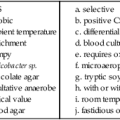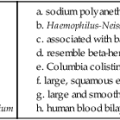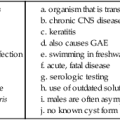Microbial Taxonomy
1. Define classification, identification, species, genus, and binomial nomenclature.
2. Properly use binomial nomenclature in the identification of microorganisms, including syntax, capitalization, and punctuation.
3. Identify a microorganism’s characteristics as either phenotypic or genotypic.
4. Describe how the classification, naming, and identification of organisms play a role in diagnostic microbiology in the clinical setting.
Classification
• Species (specific epithet; lower case Latin adjective or noun)
• Genus (contains similar species)
• Family (contains similar genera)
• Order (contains similar families)
• Class (contains similar orders)
• Phylum (contains similar classes; equivalent to the Division taxa in botany)
Identification
Microbial identification is the process by which a microorganism’s key features are delineated. Once those features have been established, the profile is compared with those of other previously characterized microorganisms. The organism can then be assigned to the most appropriate taxa (classification) and can be given appropriate genus and species names (nomenclature); both are essential aspects of the role taxonomy plays in diagnostic microbiology and infectious diseases (Box 1-1).
Identification Methods
A wide variety of methods and criteria are used to establish a microorganism’s identity. These methods usually can be separated into either of two general categories: genotypic characteristics and phenotypic characteristics. Genotypic characteristics relate to an organism’s genetic makeup, including the nature of the organism’s genes and constituent nucleic acids (see Chapter 2 for more information about microbial genetics). Phenotypic characteristics are based on features beyond the genetic level and include both readily observable characteristics and characteristics that may require extensive analytic procedures to be detected. Examples of characteristics used as criteria for bacterial identification and classification are provided in Table 1-1. Modern microbial taxonomy uses a combination of several methods to characterize microorganisms thoroughly so as to classify and name each organism appropriately.
TABLE 1-1
Identification Criteria and Characteristics for Microbial Classification
| Phenotypic Criteria Examples | Principles |
| Macroscopic morphology | Characteristics of microbial growth patterns on artificial media as observed when inspected with the unaided eye. Examples of such characteristics include the size, texture, and pigmentation of bacterial colonies. |
| Microscopic morphology | Size, shape, intracellular inclusions, cellular appendages, and arrangement of cells when observed with the aid of microscopic magnification. |
| Staining characteristics | Ability of an organism to reproducibly stain a particular color with the application of specific dyes and reagents. Staining is used in conjunction with microscopic morphology for bacterial identification. For example, the Gram stain for bacteria is a critical criterion for differential identification. |
| Environmental requirements | Ability of an organism to grow at various temperatures, in the presence of oxygen and other gases, at various pH levels, or in the presence of other ions and salts, such as NaCl. |
| Nutritional requirements | Ability of an organism to utilize various carbon and nitrogen sources as nutritional substrates when grown under specific environmental conditions. |
| Resistance profiles | Exhibition of a characteristic inherent resistance to specific antibiotics, heavy metals, or toxins by certain microorganisms. |
| Antigenic properties | Establishment of profiles of microorganisms by various serologic and immunologic methods for determining the relatedness among various microbial groups. |
| Subcellular properties | Establishment of the molecular constituents of the cell that are typical of a particular taxon, or organism group, by various analytic methods. Some examples include cell wall components, components of the cell membrane, and enzymatic content of the microbial cell. |
| Genotypic Criteria Examples | Principles |
| Deoxyribonucleic acid (DNA) base composition ratio | DNA comprises four bases (guanine, cytosine, adenine, and thymine). The extent to which the DNA from two organisms is made up of cytosine and guanine (i.e., G + C content) relative to their total base content can be used as an indicator of relatedness or lack thereof. For example, an organism with a G + C content of 50% is not closely related to an organism with a G + C content of 25%. |
| Nucleic acid (DNA and ribonucleic acid [RNA]) base sequence analysis, including hybridization assays. | The order of bases along a strand of DNA or RNA is known as the base sequence. The extent to which sequences are similar (homologous) between two microorganisms can be determined directly or indirectly by various molecular methods. The degree of similarity in the sequences may be a measure of the degree of organism relatedness, specifically, the ribosomal RNA (rRNA) sequences that remain stable in comparison to the genome as a whole. |
Although the criteria and examples in Table 1-1 are given in the context of microbial identification for classification purposes, the principles and practices of classification parallel the approaches used in diagnostic microbiology for the identification and characterization of microorganisms encountered in the clinical setting. Fortunately, because of the previous efforts and accomplishments of microbial taxonomists, microbiologists do not have to use several burdensome classification and identification schemes to identify infectious agents. Instead, microbiologists use key phenotypic and genotypic features on which to base their identification in order to provide clinically relevant information in a timely manner (see Chapter 13). This should not be taken to mean that the identification of all clinically relevant organisms is easy and straightforward. This is also not meant to imply that microbiologists can only identify or recognize organisms that have already been characterized and named by taxonomists. Indeed, the clinical microbiology laboratory is well recognized as the place where previously unknown or uncharacterized infectious agents are initially encountered, and as such it has an ever-increasing responsibility to be the sentinel for emerging etiologies of infectious diseases.







